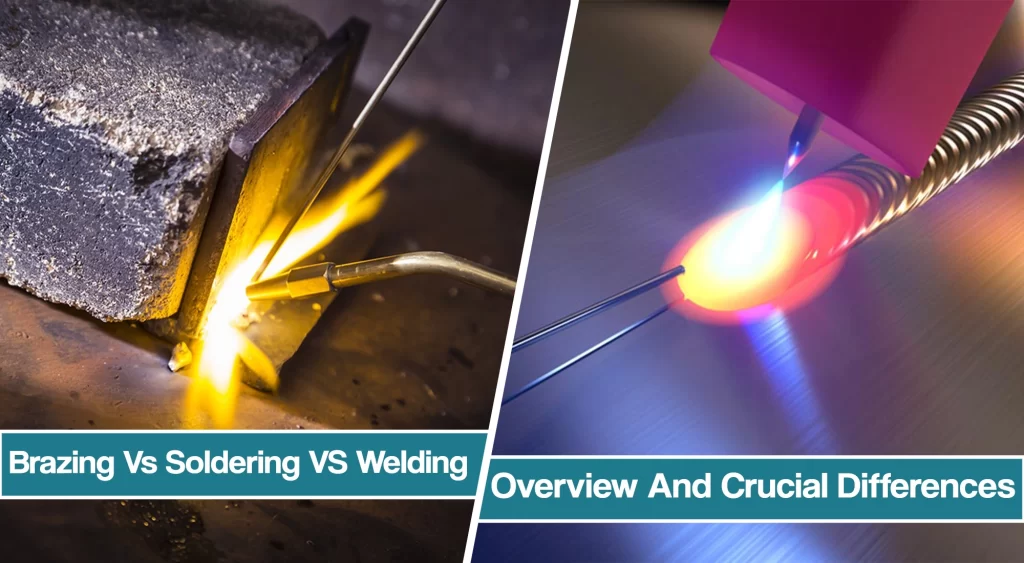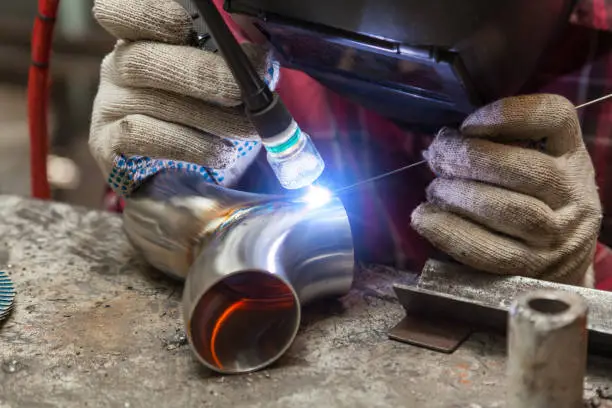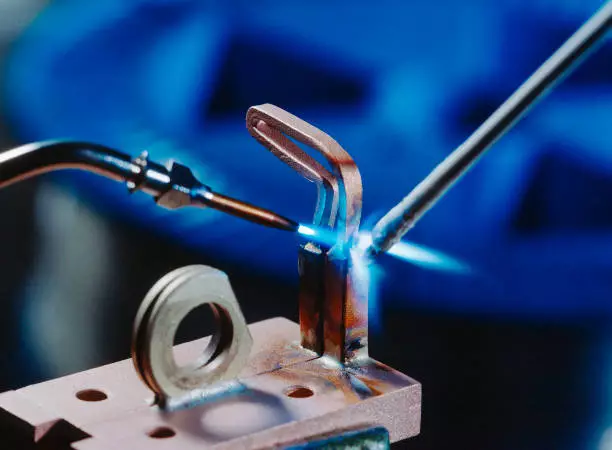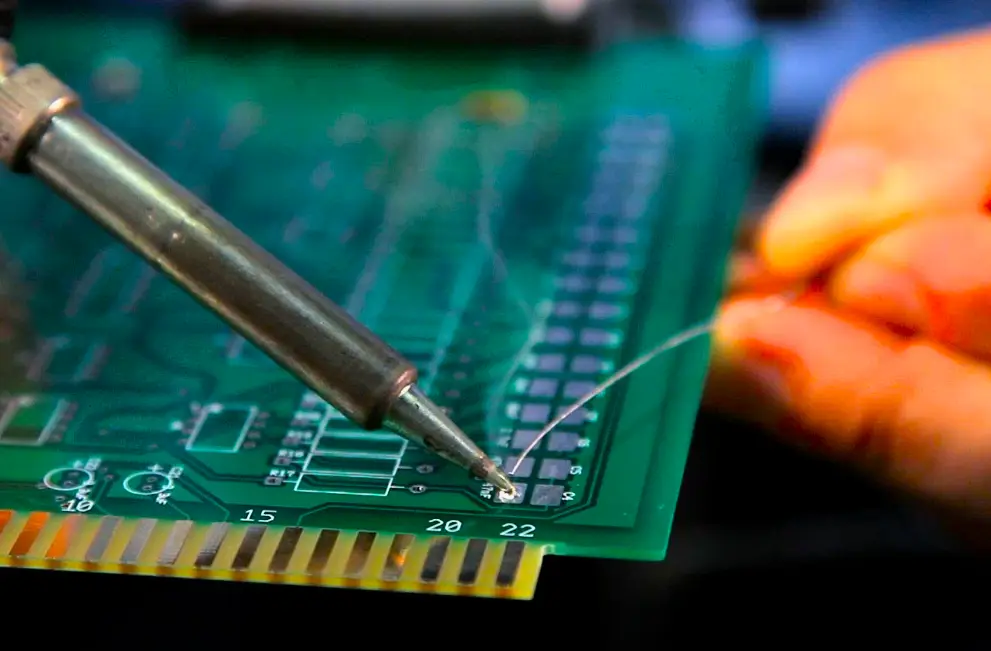Welders can join two metals using various methods, and most often, welding, soldering, and brazing are the go-to choices. All three metal joining processes use heat, but the crucial differences are the temperature needed and the heat source.
All three metal joining processes are suited for different metals and applications and involve different skills, gear, and equipment.

However, knowing the fundamentals and differences in brazing vs soldering vs welding is essential for achieving the best results.
Quick Comparison Table of Welding, Brazing, and soldering
| Properties | Brazing | Soldering | Welding |
|---|---|---|---|
| Strenght | Joints are stronger than soldering, but weaker compared to welding | Weakest joints of all three joining processes | The strongest joints with high load bear |
| Temperature | Heat goes above 840°F | Required heat is below 840°F | The heat goes up to 6500°F |
| Included heat | Doesn't reach melting point of base materials | Doesn't reach melting point of base materials | Base material is melted and they fuse together while solidifying |
| Properties of base metal | Mechanical properties of base metal are not affected | No change in mechanical properties | The mechanical properties of base metal might change after the process |
| Cost/Skill | Low costs and skill required | Very low costs and skill requirements | Somewhat higher costs and skill requirements |
| Heat treatment | No heat treatment is required | No heat treatment is required | In certain applications, heat treatment is used eliminate negative effects of welding |
| Preheating | Preheating occurs only in specific applications | Preheating improves joint strength and quality | Preheating is beneficial for brazed joints |
Brief Overview of Welding
Welding is a fabrication process that joins two or more parts utilizing high heat, pressure, or both. Welding has been used to join most metals known to humankind, but the process is extensively used for common manufacturing materials, such as aluminum, steel, and titanium.
Essentially, the high temperature heats the filler material and edges of the base metal to establish a strong weld between the workpieces of metals.

The temperature must be very high to join the two pieces together, yet not too high to change the mechanical properties of the base metal.
The welded joints created by welding can withstand all kinds of stresses. As a result, welding is widely used in construction, building, automotive, shipbuilding, aircraft, pipelines, vessels, heavy construction equipment, etc.
Welding Processes
Today, there are over 30 different welding processes. However, as a hobbyist, home shop owner, or a fabricator, you are most likely to use one of the four most common:
- MIG welding: also referred to as Gas metal arc welding (GMAW), is one of the most straightforward welding methods. An electric arc is formed between the metal and a filler wire electrode (filler metal), applying heat to the metal pieces. Due to ease of use and high productivity rates, MIG welding is one of the most popular processes and go-to welding methods.
- TIG welding: also referred to as Gas tungsten arc welding (GTAW), is one of the challenging welding techniques, but it results in clean, aesthetic welding joints. A non-consumable tungsten electrode heats the objects to form a bond. The weld is protected and cooled with an inert shielding gas such as argon or helium. Due to high cleanliness, TIG welding is often used to weld aluminum, titanium, and other exotic metals.
- Stick welding: Shielded metal arc welding is one of the cheapest welding methods and often the choice for on-field jobs and repairs. The weld is formed between a flux-coated electrode and base metals. As a result, a strong joint is formed.
- Flux Core welding: Flux-cored arc welding process uses continuously fed self-shielded wire that protects welded joint and creates a strong joint. While similar to Gas Metal Arc method, Flux-core welding doesn’t require a shielding gas, making it suitable for outdoor welding on thicker metals.
Pros and Cons of Welding
Pros
- Produces stronger joints compared to brazing or soldering
- Assembled welded joints are significantly more resistant to high-temperature applications
- Capable of joining noticeably thicker metals (depending on process type)
Cons
- Higher heat input results in more significant thermal distortion and residual stresses in the joint compared to the soldering and brazing process.
- In specific applications, post-processing heat treatment is required in order to reduce residual stress.
- Specific welding methods and materials are not suitable for joining dissimilar metals
Brazing process Overview
In the brazing process, metals are joined with molten filler metal, creating permanent solid bonds.
Brazing utilizes temperatures above 840°F (450°C) to reach the melting point of filler metals, but the mechanical properties of the base metal remain unaffected.
Once the filler materials are molten, capillary action draws the filler metal into the brazed joint. Therefore, a specific joint design is required to achieve capillary action by liquid filler metal.

While heated slightly above the melting point, the filler metal is protected by a suitable atmosphere, which is often supplied by a flux. The flux also helps clean the metal surfaces, remove oxides and promote wetting and capillary action.
Unlike welding, brazing can be used to join dissimilar metals, such as gold, silver, copper, and nickel. As a result, brazing is a commercially accepted process used in a wide range of industries due to its flexibility and the high integrity to which joints may be produced.
Depending on the heat sources, there are several methods. They include torch brazing, vacuum brazing, furnace brazing, and induction brazing.
Brazing Pros and Cons
Pros
- Lower power input and relatively low temperatures compared to welding result in minimal thermal distortion and residual stresses
- The low temperature reaches the melting temperature of the filler metal, not the base metals
- There is little to no post-processing heat treatment and actions increasing the ove
- Capable of joining dissimilar materials
- Brazed joints are more potent compared to soldering
Cons
- Brazed joints are weaker compared to welding
- Achieved brazed joints are not suitable for high-temperature applications as welds
- Fluxes may contain toxic components, and they require post-braze cleaning as residue might impact the strength of the bond
Soldering process Overview
Brazing and soldering are fundamentally the same metal joining methods, as they use heat melt filler metal. However, the filler requires a soldering temperature lesser than 840°F (450°C).
In addition, both brazing and soldering use flux to clean the metal surfaces, allowing a more manageable flow of the liquid filler metal over the base material. The soldering process is suitable for joining brass, copper, iron, gold, and silver.

As a result, the process is widely used in the electronics industry to make electrical contacts, connections, and electronic devices, such as joining copper to printed circuit boards (PCB). In addition, plumbers use soldering to weld copper pipes.
Pros and Cons of Soldering
Pros
- Lower heating and process temperature compared to welding and brazing make soldering suitable for thin-walled parts
- Capable of joining dissimilar base materials
- Minimal thermal distortion and residual stresses in the soldered joints
- There is no need for post-processing heat treatment
Cons
- Soldered joints are significantly weaker when compared to welding and brazing, making them unsuitable for load-bearing applications.
- Not suitable for joining metals that are thick
- Joined metal parts are unsuitable for high-temperature applications
Brazing vs Soldering vs Welding – What Are The Differences?
What Is The Difference Between Brazing and Soldering?
The crucial difference between brazing and soldering is the temperature required to reach the melting temperatures of the filler material. Soldering takes place at a temperature below 840°F (450°C), and brazing occurs at a temperature above 840°F (450°C).
As a result of different melting points, the brazed joint strength is higher than soldering welds. However, the bond created by these processes is noticeably weaker compared to welding.
What Is The Difference Between Welding and Soldering?
While both metal joining processes use heat to join metal pieces, the main difference is in the temperature needed and heat sources.
Soldering is applied via torch, furnace, induction, dipped or resistance as heat sources taking place at a temperature below 840°F (450°C). Meanwhile, welding utilizes electric current to reach temperatures of roughly 10,000 degrees Fahrenheit.
As a result, welding creates a very strong bond that can withstand high temperatures and stress. However, low-temperature process such as soldering is more suitable for thin metals and different materials.
What is the Difference Between Welding and Brazing?
The key difference between welding and brazing is the temperature and heat source. Brazing is applied via torch, furnace, induction, or resistance at temperatures above 840°F (450°C), while welding temperatures can reach 10,000 degrees Fahrenheit.
Due to high heat, welding can cause thermal distortion and residual stresses in the welded joints. Meanwhile, brazing temperatures are high enough to melt filler metals, but they don’t interfere with base metal properties.
However, welded joints are significantly stronger, and heat and stress-resistant compared to brazing bonds.
Resources:
- https://www.uti.edu/blog/welding/brazing-soldering-welding
- https://www.twi-global.com/technical-knowledge/faqs/welding-brazing-and-soldering
- https://www.cruxweld.com/blog/the-difference-between-soldering-and-brazing/
- https://lucasmilhaupt.com/EN/Brazing-Academy/Brazing-vs-Welding.htm
- https://www.kaempfandharris.com/industry-news/difference-between-brazing-and-welding





